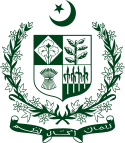| ||||||||||||||||
150 of the 156 seats in the National Assembly 76 seats needed for a majority | ||||||||||||||||
This lists parties that won seats. See the complete results below. | ||||||||||||||||
 |
|---|
|
|
General elections were held in Pakistan on 21 March 1965.[1] The National Assembly was elected indirectly by the basic democracy electoral college system, with electoral college members elected in October and November 1964.
YouTube Encyclopedic
-
1/5Views:205 5661 7605377796 600
-
Ayub Khan On Indo-Pakistan Conflict And Scenes (1965)
-
T#8-L#49-ELECTIONS OF 1965 - complete historical perspective-History of Pakistan-Pakistan Affairs
-
Ayub Era. Martial law,Basic Democracy, Family Law Ordinance and General Elections 1965
-
IMPACTS - Pakistan's presidential elections of 1965- social, political, historical. css pms
-
Lecture No. 65 | Presidential Election 1965 In Pakistan | by Sajid Ali
Transcription
Background
The 1962 constitution provided for an indirectly elected 156-seat National Assembly, of which 150 seats were elected from single-member constituencies by electoral colleges and six seats reserved for women,[2] who were elected by the 150 general members.[1] The seats were divided equally between East and West Pakistan.[2] There were 80,000 members of the electoral college ("basic democrats"), 40,000 in each wing.[3]
The electoral college members were elected between 31 October and 9 November 1964 in West Pakistan and from 10 to 19 November in East Pakistan.[4] A total of 264,254 candidates submitted nomination papers, of which 192,416 were successfully registered after disqualifications, withdrawals and retirements.[4] 11,652 were elected unopposed.[4]
The first task of the basic democrats was to elect the president, which occurred on 2 January 1965.[5]
Results
Several opposition parties, including the Awami League, the Council Muslim League, Jamaat-e-Islami, the National Awami Party and its northwestern Wali faction, as well as the Nizam-e-Islam Party, formed a coalition to contest the elections as the Combined Opposition Parties.[5]
A total of 672 candidates submitted nomination papers for the National Assembly elections, of which 437 were approved.[1] 18 candidates were elected unopposed from constituencies with 10,651 basic democrats.[1][4]
The Pakistan Muslim League won 120 seats and the opposition Combined Opposition Party and National Democratic Front 16.[1] 25 incumbent MPs lost their seats, including one minister.[1]
| Party | Seats | |
|---|---|---|
| Pakistan Muslim League | 120 | |
| Combined Opposition Parties | 10 | |
| National Democratic Front | 6 | |
| Independents | 14 | |
| Total | 150 | |
| Source: Kamran | ||
See also
References
- ^ a b c d e f Sharif al-Mujahid (November 1965). "The Assembly Elections in Pakistan" (PDF). Asian Survey. 5 (11): 538–551. doi:10.2307/2642133. JSTOR 2642133.
- ^ a b The Commonwealth Relations Office Year Book, Volume 13. 1964. pp. 289–291.
- ^ Syedur Rahman (2010). Historical Dictionary of Bangladesh. Scarecrow Press. p. liv. ISBN 978-0-8108-7453-4.
- ^ a b c d M. Rashiduzzaman (1968). "Indirect elections in Pakistan" (PDF). Zeitschrift für Politik. 15 (3): 326–336. JSTOR 24222743.
- ^ a b Tahir Kamran. "Electoral Politics in Pakistan (1955-1969)" (PDF). p. 92.


